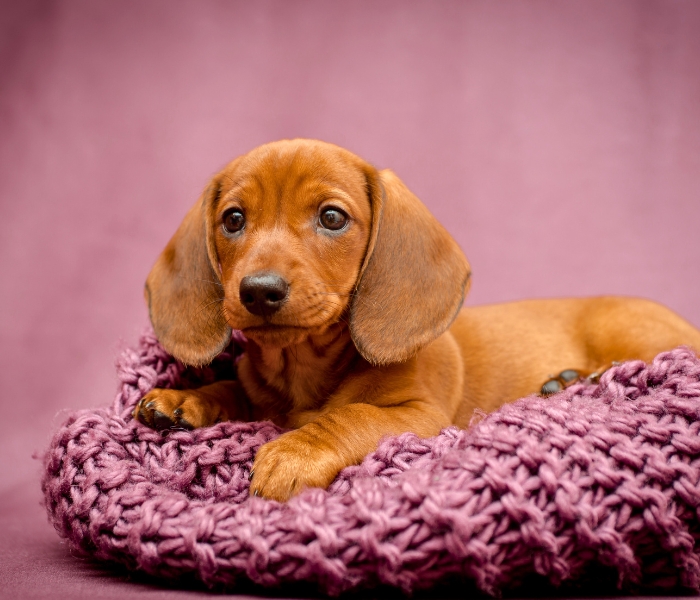
Complete Dachshund Puppy Guide: 10 Tips for New Puppy Parents
Raising a Dachshund puppy is an exciting and heartwarming journey, but it can also come with its fair share of challenges.
This Complete Dachshund Puppy Guide is packed with everything you need to know about Dachshund puppy care and training, all in one convenient place.
From essential tips for navigating those early weeks to our comprehensive Dachshund puppy training guide, you’ll find the tools you need to survive. I will show you how to make this stage more enjoyable and rewarding for both you and your pup.
Table Of Contents:
Male or Female Dachshund?
All Dachshunds have their own unique personality, no two doxie are alike. When I was young, my female Dachshund was extremely well-behaved and could be left in the house while my family would go on vacation. She just needed someone to stop in a couple of times per day for food, water, and potty time.
On the other hand, as an adult with my own family, my experience is slightly different. My male Dachshunds can’t be left alone in my home for more than one hour without getting into some sort of trouble. They require a playpen when we leave home, and boarding services when we go on vacation (or they come with us).
Male Dachshunds and female Dachshunds are often quite different as far as behavior is concerned.
I had a long discussion with a woman I met at a Dachshund festival about the male and female doxies.
She had owned 10 different doxies over the years and observed that the females were much more independent, while the males often required a bit more love and attention from their owners.
Things You Need for a Dachshund
Preparing for your new Dachshund puppy starts with having the right supplies ready before they come home. A little planning goes a really long way in helping you and your pup get off to the absolute best start! Here’s a checklist of must-have items.
• Dog Bowls
• Dog Leash
• Dog Body Harness
• Puppy Gates
• Puppy Playpens
• Dog Food
• Dog Toys
• Puppy Pads
• Dog Beds
• Dog Blankets
• Puppy Shampoo
Dog Bowls:
When it comes to choosing the perfect dog bowl for your Dachshund, go with food-grade ceramic, silicone or stainless steel. These materials are non-porous and dishwasher safe.
Dachshunds are known for their quirky eating habits. They love to nudge their food bowls around the floor or even try to ‘bury’ their food under a toy or blanket. To keep mealtime less messy, consider dog bowls with rubber grips on the bottom or ones with extra weight to prevent tipping.
Because doxies tend to gobble up their food in super speed mode, slow feeder dog bowls are a game-changer for this breed! They help your doxie eat much slower, which promotes healthy digestion and reduces risk of bloating and tummy troubles.
Related Post: Best Slow Feeder Bowls for Dachshunds
Dog Leash:
I have owned many dog leashes over the years. The best ones are thicker, rope-like material that their little scissor back teeth can’t slice through. This happened every time we went camping. While we were setting up our tent, we secured the dogs around a nearby tree so they wouldn’t wander off into the woods. Literally, before the tent was up, one of the Dachshunds was free as a bird wandering around the campsite.
One dog would still be secured on a complete leash, the other leash was cut in half. I never actually caught them doing it, so I wasn’t sure if one dog released the other or that dog released himself, it will always be a fun mystery. Stick with rope leashes, or dog leashes that aren’t paper thin, they’ll last longer.
Dog Body Harness:
Grab a couple of different collars and harnesses for your Dachshund. For daily walks, I highly recommend dog body harnesses to protect their delicate back and neck.
Harnesses are a good idea for the doxie who loves to pull constantly. There’s always that fear that they may slip out of a dog collar in pursuit of a squirrel or another dog.
When we take our Dachshunds hiking, we have one pup who does just fine with his regular neck collar, but the other one pulls so hard that he is coughing and hacking throughout the walk.
Post You May Like: Best Harness for Dachshunds
Puppy Gates:
You will need to pick up some puppy gates to protect your home and your new pup. Get a couple of individual doorway gates that easily secure to your door frame and some gates for your stairs as well.
Playpen vs Kennel:
Many people consider using a dog kennel for their Dachshund when they leave home, but that’s not my personal preference.
I learned early on that my dachshunds much prefer open-topped puppy playpens.
These playpens allow me to step inside for playtime and training sessions, which helped my doxies associate the space with safety and comfort. They were much more relaxed when I had to step out for a bit or leave for the afternoon.
While dog kennels work well for some, I found them less suitable for my little long dogs.
In my home, I use a puppy playpen in my bedroom at night for bedtime and another playpen in the kitchen during the day (when I need to step out). Playpens provide plenty of space for my dachshunds to lie down, ear, or play, making them a perfect fit for our daily routine.

Dog Food:
Always feed your Dachshund high quality puppy food when they are young. After they turn 1, you can switch them to high quality dog food for adult dogs. Ask your veterinarian to see what they recommend. That’s how I found the perfect food for my doxies.
We currently alternate between Science Diet Lamb and rice and our delicious homemade dog food recipe (for dachshunds over the age of 1).
Look for a dog food that has quality food ingredients and less fillers. See DogFoodAdvisor.com for the best reviews on a variety of Dog Foods.
Dachshund Toys:
Dachshunds enjoy chasing balls, playing with treat dispensing toys, and completely demolishing their squeaky toys. Most doxies have their plush squeaker toys shredded within minutes – and that’s ok! Just keep in mind, they don’t need an expensive toy that won’t last.
A perfect toy box for a Dachshund puppy should include: lots of safe puppy chews, dog balls, several plush squeaky toys, fleece dog toys, and some treat dispenser toys.
Don’t bother with the thin plastic-based squeaky toys. Your pup will swallow the small pieces of plastic.
Trade for the Squeaker: Stick with plush toys that have the squeaker inside. When your dog reveals the squeaker, redirect them with a treat or another toy to prevent them from chewing on it or swallowing it.
Avoid simply taking it away without offering something in return, as this can teach them to expect items to be taken away and may lead to resource-guarding issues.
For that special occasion, take your pup to the pet store and let them choose from a few different types of toys. Give them the option, they will love it.
Post You May Like: How To Find The Perfect Toy For Your Dachshund
Puppy Pads:
You don’t need to go out get the 1000 pack of puppy pads, just get a couple of regular-sized packages to start their house training.
Post You May Like: How To Potty Train A Dachshund
Dog Beds:
Pick up a couple of nice soft beds for your doxie. Dog beds come in all shapes and sizes, but don’t purchase anything too expensive for a new puppy right away.
Everything for the puppy will get chewed up, de-stuffed, peed on…you name it. Choose puppy beds that can fit in your washing machine for easy cleanup.
Dog Blankets:
Don’t go too crazy with your puppy’s new doggie blankets. Just see if you have a some old spare blankets in your closet that you don’t need anymore. They love fabric with your scent on it, it helps them feel comforted while they are sleeping.
Puppy Shampoo:
Pick up a gentle puppy shampoo that is hypoallergenic and tear-less. Oatmeal-based puppy shampoos rank higher as far as gentleness for puppies.
Note: Don’t use people shampoo.
I know it may seem tempting and just more convenient, but our people shampoo is formulated for our skin and hair, not your dog’s fur. It will dry out your Dachshund’s coat and could cause itchy skin conditions.
Post You May Like: How To Prevent And Treat Dachshund Skin Issues
Puppy’s First Day:
Let your new puppy go on a sniff journey when they come home – fully supervised of course! Sniffing out their new surroundings and getting to know your family will help them feel comfortable in their new home.
Take it Slow: Avoid overwhelming your new puppy. Give them time to adjust at their own pace.
Lots of Sleep: It’s totally normal for a new dachshund puppy to nap several times a day. Getting to know you and your family, exploring new surroundings, and learning the house rules can be quite exhausting. Plenty of quiet naps are essential for a healthy pup.
Puppy’s First Evening:
At bedtime, it’s perfectly fine to have your puppy in a playpen near your bed so you can hear them cry when they need to go potty outside.
When I was potty training my puppy at night, I let them sleep in a puppy bed next to me in my bed. This way, they didn’t cry and keep us both awake at night, and I could hear them whimper when they needed to go out.
Once they were fully trained, I moved them to their own playpen and doggie bed for nighttime.
Puppies Can’t Hold It! Be prepared to wake up 1-2 times per night for the first couple of weeks until your puppy can hold it longer as they grow. Nighttime potty training involves teaching them to alert you when they need to go outside.
When they cry, take them outside right away. Once they finish going potty, praise them briefly and return to bed. Avoid giving them attention or playing during these nighttime trips.
Watch my Dachshund puppy nighttime training video on YouTube.
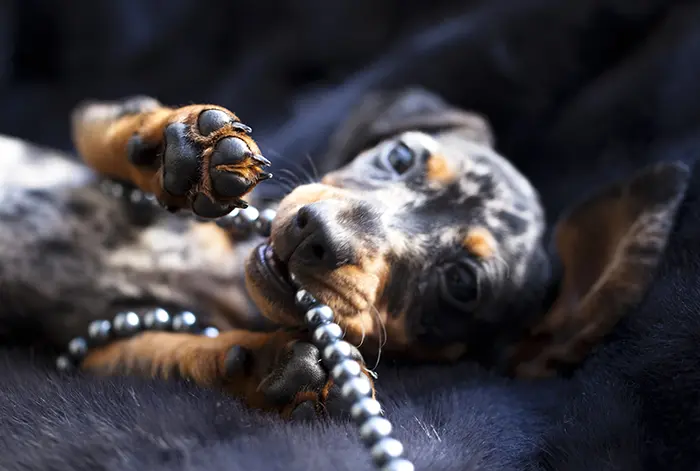
Dachshund Proof Your Home
When a new puppy is set free in the home, they Will look for a place to go potty and they Will get into everything – guaranteed! Many owners feel this is a behavior problem, when in fact, it is due to a lack of puppy proofing.
Puppy-Proofing Checklist
1. Hide Chewable Items:
Get down on the floor and look through your puppy’s eyes, what can they get into? Because they will!
Cords and Strings:
Hide the electrical cords. If your puppy chews on an electrical cord, this can result in a severe burn or a deadly shock. Tape down all your loose cords and also secure your window shade strings.
Small Toys:
Keep small bouncy balls and child toys away from your pup. They can easily block your pup’s airway, causing suffocation. Hide the school supplies. Pencils and colorful erasers are attractive, choking hazards for dogs.
Household Items:
Puppies love to grab, run, and chew everything on the floor to get some attention. They also love to chew on furniture (especially while teething).
Guard The Following Items:
- Socks
- Shoes
- TV remotes
- Game controllers
- Jewelry
- Furniture
- Pillows
- Houseplants
- Cat litter
- Dryer sheets
2. Use Puppy Gates:
If there are rooms in your house where there are too many things to hide, install a puppy gate in the doorway. Don’t allow your dog into the garage or the shed where there are a lot of dangerous objects that are hard to avoid.
3. Create a Designated Puppy Area:
Your designated puppy area should have an easy-to-clean floor (vinyl or tile) and a puppy playpen or baby gates.
Keep the puppy area away from your walls, cords, or any wooden corners where they might chew.
Dachshund puppies love to chew and pee on everything.
If you aren’t able to be your puppy’s shadow, put them in the designated puppy area. It is meant to be a safe and cozy place for your puppy to go when you aren’t able to watch them. Also, a great place for nap time.
4. Baking Ingredients:
Dogs are attracted to the smell of chocolate. Put all baking chocolate and baking ingredients up high and locked away, they are toxic dogs.
5. Lock Up the Chemicals:
Install child locks on your cleaning product cabinets. Dachshunds are curious little dogs and will try to get into everything. If your dog ever consumes any chemicals, call your vet or the Pet Poison Hotline ASAP.
6. New Puppy Rules for the Family:
Small Children:
If you have small children, teach them to be extra gentle around the puppy. If the puppy is teased or constantly bothered, they will learn to defend themselves, which can lead to aggression.
No Jumping:
Dachshunds have fragile spines and are prone to a disease called IVDD. All Dachshunds should avoid high-impact activities like jumping and any activity that will put too much strain on their back. Purchase plenty of dog ramps for your furniture to help prevent injury.
People Food:
Avoid feeding your Dachshund any people food. Feeding them table scraps during a meal will quickly become a hard to break habit for you and your dog.
Table scraps are not safe for your doxie. Some little long dogs have extremely sensitive stomachs, so any table scraps may make them very sick. Check out this list of toxic foods your dog should never eat from the ASPCA.
Read This! How To Avoid IVDD In Dachshunds
7. Garbage:
Lock down ALL of your garbage cans. Dachshunds love sniffing out your garbage in the kitchen and the bathrooms. Place the cans where your pup can’t reach it or get one with a locking top.
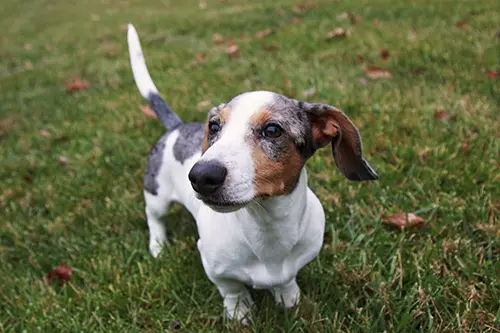
Puppy Proofing Tips for Your Yard
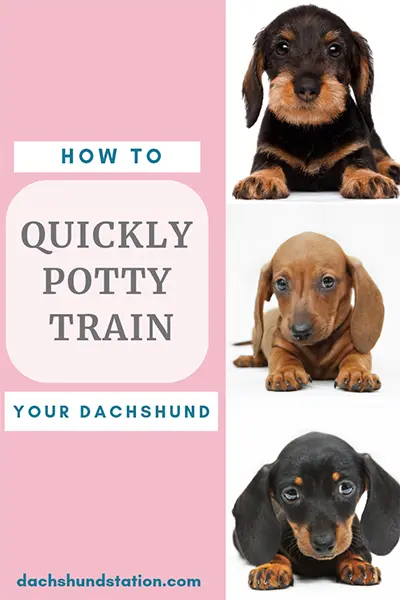
How To Potty Train a Dachshund
Potty training a new Dachshund puppy can be a challenge. It is repetitive and time-consuming, but very necessary.
Consistency is key! Puppies can learn to potty train very quickly when you keep a consistent routine. Your puppy will not be training themselves; they need your guidance every step of the way.
Dachshund Puppy Housetraining Tips
1. Puppy Potty Clues:
You can start potty training your Dachshund puppy around 8 weeks of age. I understand many doxie parents have mentioned that some regions have strict rules from their vet to wait until puppies are fully vaccinated. Follow your vet’s recommendations to keep your puppy safe.
Take your puppy outside frequently for potty breaks to prevent them from having to use the puppy pads in the house. Use puppy pads only as a backup, not as the potty trainer.
Puppies have predictable elimination times. Always take them out to go potty during the following events:
- When they wake up
- After They Eat
- After Exercise or Play
- Before they go to bed at night
If you spot your puppy doing any of the following, it’s time to let them outside.
- Sniffing the ground
- Turning around in circles
- Looking nervous
- Acting worried
- Whimpering
2. Designate House Area
Keep your puppy in a gated section of the house that has easy to clean floors. Use newspapers or puppy pads at the beginning of your training, but they are not to be used exclusively.
Sometimes it is hard to cover all of your entrances, so I like to use those large science fair project boards or thicker craft project poster boards from Walmart to secure those hard to cover areas.
Having a designated play area for your pup allows you to put them in a safe space when it’s time to take a nap or when biting and chewing gets out of hand.
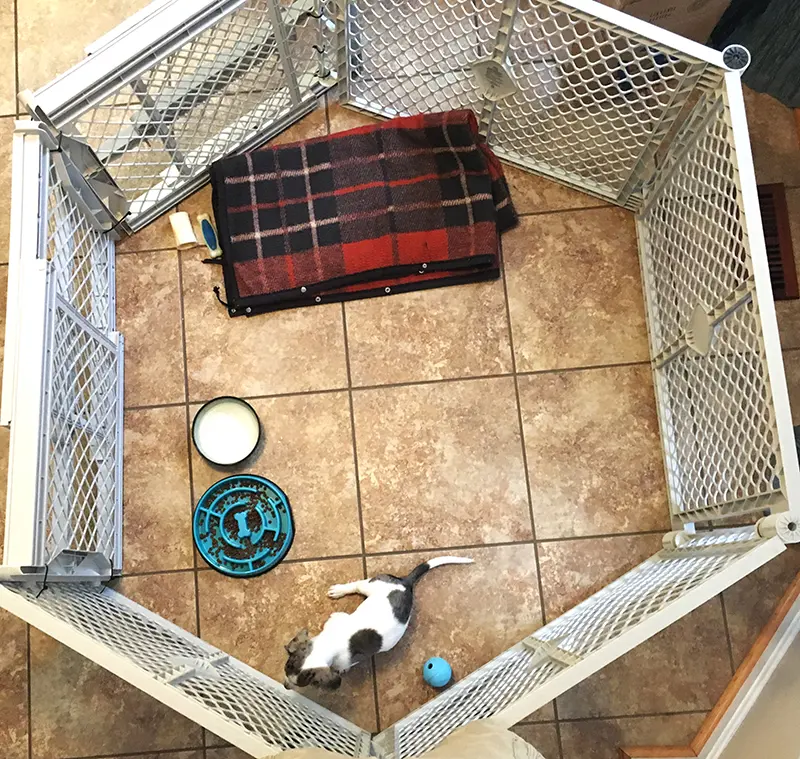
3. Designate Yard Area
It is recommended that your Dachshund puppy use a designated section of the yard as their potty spot. They will start to understand what they need to do when you take them to that same spot over and over again for pees and poos.
This is not only a big benefit to your yard, but also your shoes! Dog poo is a pain to clean off sneaker treads. Don’t let them roam the entire yard during the training process, this may cause confusion and delay the potty training process.
If you take your puppy outside to go potty and they don’t eliminate after 5-10 minutes, put them right back into their playpen or crate and watch them closely. When they show signs of having to go, take them outside quickly.
4. Watch Carefully and Move Quickly
Watch your puppy constantly when they aren’t in their designated area! If you notice your puppy showing any of the potty clues above, move them outside quickly.
Super Important Tip! If you catch them mid pee or poo, pick them up and take them outside…even if they are still going. Try not to get upset, just put them outside in the potty spot and give them praise. This will help them realize where they are supposed to go potty.
When an accident happens in the house without you noticing, don’t get upset. Puppies don’t understand why they can’t go potty in the house. Your puppy loves you and is very capable of learning.
Accidents are a part of the learning process, be patient. It is up to you to keep on top of them to make this training successful.
Training Tip: Puppies aren’t fully in control of their bladder until about 6 months old. Understand that when they have an accident prior to this age, they aren’t able to hold their bladder for more than a couple of hours. So, it really isn’t their fault.
Do NOT Punish! Punishing during the house-training phase may prolong training time and make it more difficult than it has to be. The old methods of sticking your puppy’s nose in it are gone! Use positive reinforcement instead.
5. Praise and Reward
When your puppy goes potty outside, praise them with “Good” and give a small treat. Then, take them back inside the house. Your Dachshund will begin to connect your designated potty yard spot with getting a positive reward and returning to the house.
6. Hired Help
If you are unable to let your dog out during the day, get some help.
Note: Your dog (puppy or adult age) should Never be crated for more than 4 hours!
Ask your friendly stay-at-home mom if they want to earn some extra money for letting your dog out during the day. Or, you can search online for some local dog walkers in your area.
Whether you are potty training your new pup or leaving your trained dog at home while you are gone most of the day, getting someone to let them out will prevent accidents. It will also help your dog remain calm while you are away and lower the risk of Separation Anxiety Issues.
Potty Training Steps:
Potty Training Video Guides
Looking for more of a visual step-by-step puppy potty training video to follow? Look no further.
Here is our complete Dachshund puppy potty training playlist on our YouTube Channel.
Make sure to subscribe while you are there!
Why Is My Dachshund Still Peeing Inside?
Your new doxie pup needs to be watched the whole time they are loose in your home. If they aren’t being watched closely, they need to be in their playpen area.
Let them outside for potty breaks often and keep visiting the same potty spot in your yard to stay consistent.
If you are still having issues, definitely check out our YouTube channel for our potty training video guides.
Note: If your pup is still having accidents indoors, consult your vet. Your Dachshund may have a UTI or another medical issue causing them to have more frequent accidents that they can’t help.
Using A House Lead:
During the potty training stage, it is recommended to have your puppy wear a “House Lead” when roaming around inside your home. You can have your pup use just a regular leash and it can be attached to your pants belt loop or free to drag behind them.
It is helpful to have a lead to grab onto in case your doxie starts to go potty inside or tries to grab a pill or food off the floor.
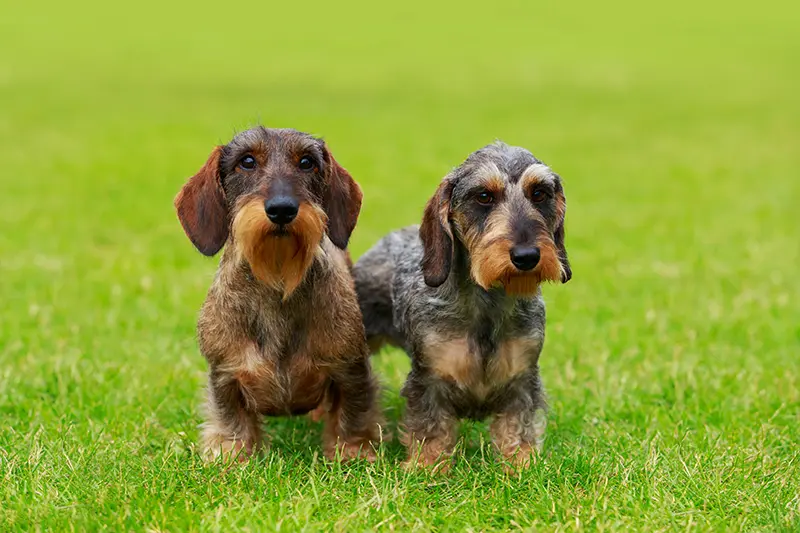
How To Socialize Your Dachshund Puppy
Why Socialized Your Puppy? Socializing your Dachshund will help them become familiar with new sounds, smells, and sights in a positive way.
Correctly socializing your pup will prevent them from becoming frightened of other animals, people, or traveling to new places. Dogs who are not socialized at the correct age are often fearful and aggressive.
The best time to start socializing your Dachshund is between 10-16 weeks old.
Tips For Socializing Your Dachshund
Once your doxie has received their initial vaccines from the vet, it’s a good time to start introducing some new furry friends. Here are some great tips to help your Dachshund become socialized:
• Introduce New Friends
• Car Rides
• Walks on a Leash
• Introduce New Sounds
• Gentle Behavior
• Don’t force a scared dog
• Reward for good experiences
Introduce New Friends
Introduce new people and animals gradually. Too much exposure to new animals or people can cause your Dachshund to become overwhelmed. Plan small doggie play dates and introduce your dog to your neighbors (with or without dogs).
Get Down to Their Level
When people are introducing themselves to your dog, ask them to get down to the dog’s eye level. Allow your dog to approach them slowly. If they are not comfortable, don’t force it, try again another time.
Car Rides
Take your doxie on car rides. Whether it is a brief ride to the park or to grandma’s house, allow your dog to tag along. Dachshunds love bye-bye rides.
If your dog is prone to getting car sick, try shorter trips in the car and be prepared with some cleanup gear in case. Also, check with your vet to make sure your Dachshund doesn’t have an ear infection. Sometimes this can cause inner ear dizziness which can lead to getting sick in a moving car.
Walks On a Leash
When you first hook up your pup to a harness and leash, they probably won’t have a clue what to do. Help your Dachshund feel safe wearing this new gear – don’t pull too hard on the leash, always be gentle. Start off with brief walks around the block. Your pup won’t go too far at first.
Make sure to secure the leash around your wrist. When a Dachshund spots another animal, they will try to bolt, so hold on tight. If you encounter another dog walker on your path, you can let the dogs sniff each other if they seem friendly enough, but keep in mind not all dogs are friendly.
Introduce New Sounds
Gradually introduce some new sounds to your Dachshund. When indoors, sound off a couple microwave beeps, a brief fire alarm, or a couple minutes of the vacuum cleaner – one each day, space it out. Allow them to lay in a nice comfortable spot a safe distance away from the loud sound.
While outside, listen for the fire engines or a distant passing train, allow them to listen and let them know they are ok.
When your Dachshund experiences a loud and unfamiliar sound, stay calm and comfort them. You can even offer them some small treats. You are helping them understand that there is no need to freak out.
Gentle Behavior
Keep small children away from your Dachshund if they play too rough or make them nervous. Allow your doxie to escape and find a safe place to hang out.
Try to keep socialization experiences positive. Whether it is a quick introduction with your neighbor or attending a puppy play date, keep things safe and positive – with small treat. A bad experience is hard to erase from any dog’s mind.
Always keep watch and protect your dog when socializing with others.
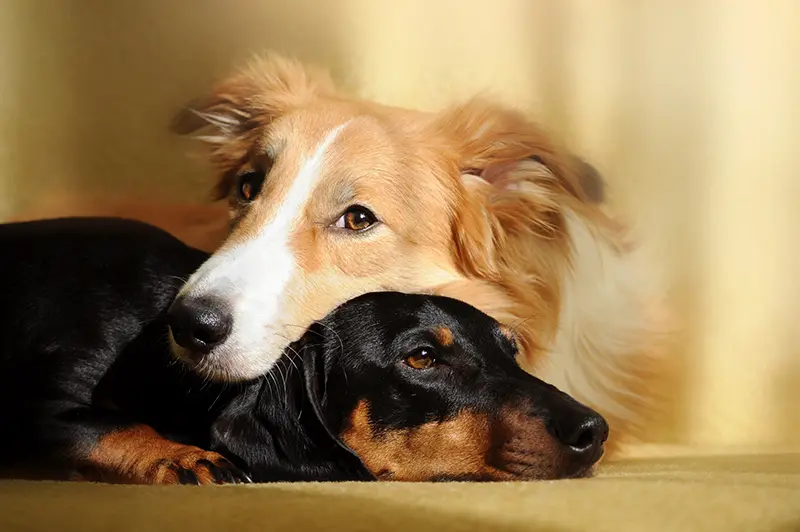
Don’t Force a Scared Dog
If there is ever a situation when your dog acts scared towards another animal, person, or place, don’t force them. Allow them to make the decision for a friendly introduction or skip it.
Forcing your Dachshund into a frightening situation will cause them to become defensive and skittish. They could possibly develop harsh instincts like biting or warning others when they feel threatened.
Reward Good Experience
Set up a puppy play date with other small dogs – close to your doxie’s size. Keep in mind, some dogs play rougher than others. It helps to match up puppy play styles to keep the experience safe and positive.
Afterward, if your pup got along with the other dogs, give them a treat on the way home. This positive behavior is an incentive to continue being an obedient Dachshund.
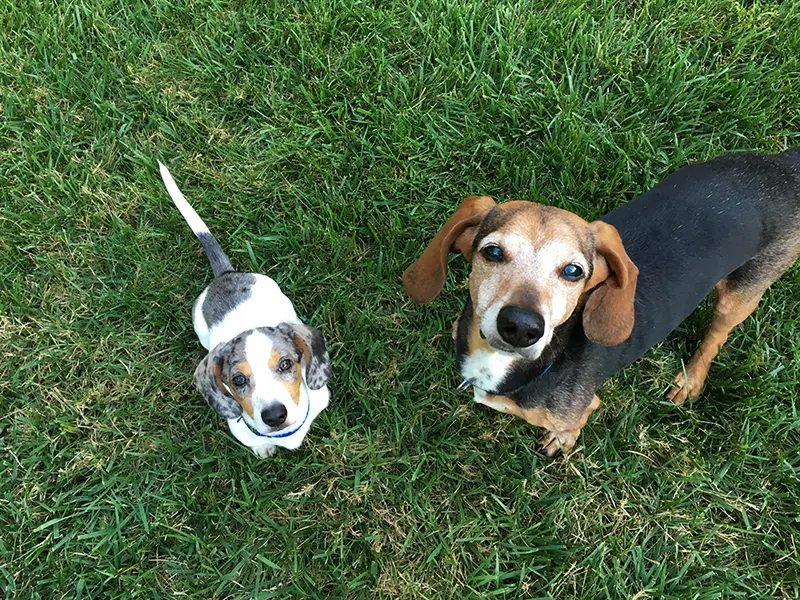
Dachshund Training Commands
Teaching your Dachshund some basic training commands is easy to do and can be fun too. It doesn’t matter if your dog is young or old, learning a new command just takes a little time, patience, and some yummy treats to achieve great success.
Only work on 1 training command per week. Too many all at once will confuse your doxie.
Dog Training Preparation:
Your training sessions will be more effective if you do some light prep work ahead of time. There are 2 Key Steps you must do before your dog training session begins. You must find the Right Location and have the Right Treats.
Location:
Some dogs have a very low attention span. Whether you have a young puppy or an older dog, focus is key. You can use a quiet hallway or a small, enclosed space in your home (with no media distractions or noise) to do your dog command training.
I would not recommend going outside for your pup’s initial training. There are a lot of smells and noises that will keep your dog’s attention away from you.
Dog Treats:
Purchase some dog training treats that your dog can’t resist. A dog treat that is soft and can be broken up into smaller pieces is perfect for a good training session. Don’t give your doxie huge chunks to chew. These treats will need to last long enough to make it through a 2-5 minute session.
Sit Command:
Let’s start with the “Sit” training command. Have about one or two tablespoons of dog treats cut into small pieces and ready to go. Position your Dachshund directly in front of you. Hold the treat at nose level and slowly move it to the back of their head.
If they sit down, make sure to say “Sit.” If your dog doesn’t sit automatically, give a gentle push on their hindquarters and say the “Sit” command. Verbally praise with “Good” and give a small treat.
Don’t put the treat too far above their nose, you want it reachable, so they don’t have to jump.
During the first couple of training sessions, try to have your dog remain in the “sit” position for a couple of seconds before rewarding with a small dog treat. Then, gradually work your way up to having them sit for 10 seconds if you can.
It is recommended to do this training a couple of times per day for about 2-3 minutes per session.
Down Command:
After your Dachshund has mastered the “Sit” command, move on to the “Down” command. Start the dog in the sit position directly in front of you.
Hold the small treat in front of their nose, and move the treat down to the ground, then give the command “down”. Your Dachshund should lean forward and follow the treat down.
While training this command to my puppy, Eko, I had to move the treat down to the floor and a little under his chest to get him to lay down. Once his stomach touched the ground, I said “Good”, and gave him a small treat.
It is recommended to do this a couple of times per day for about 2-3 minutes per session.
Stay:
Start with your Dachshund in the sit position, facing you. Then, hold your hand up, showing the palm of your hand to your dog (like a stop sign) and say “stay”.
If your pup stays in that position for a couple of seconds, verbally give praise and a small treat. Each time you practice this command, back away from your dog a little further and have them “stay” a few more seconds as you give the “stay” command.
Here is a really good video on YouTube from McCann Dogs that can help you and your dog learn the “Stay” Command.
Come:
When teaching the “Come” command, have your dog in the sit and stay position. Take a step or two away from your dog (still facing them) and say “Come”. If your dog comes to you, verbally give praise and a small treat.
It is recommended to do this a couple of times per day for about 2-3 minutes per session. Over time, increase the distance between you and your dog little by little.
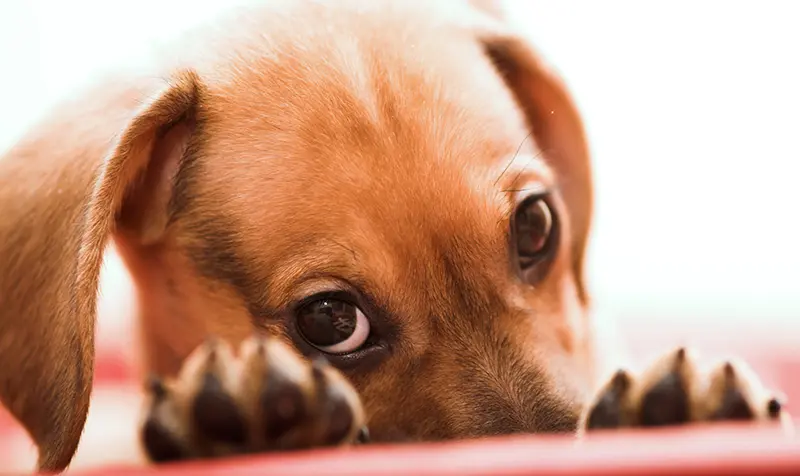
Dachshund Behavior Training
Many Dachshund owners would agree that doxies are the most loving family dog, but they can sometimes act out of spite and have choosey listening skills. It can be frustrating when experiencing behavioral issues with your doxie. Here are some tips that can help.
Keep your veterinarian in the loop of any behavior issues you are experiencing with your Dachshund. You are not alone, there are many dog owners and veterinarians out there who can share tips with you.
The Most Common Dachshund Problems
1. Dachshund Separation Anxiety
It is important to understand Separation Anxiety in your Dachshund. You want to help your pup be comfortable and content when you have to leave your home. Separation Anxiety training is needed to help your doxie learn that you will be back and they don’t need to panic or destroy something in your home while you are away.
Tips for Treating Separation Anxiety:
Leaving
To avoid triggering a separation anxiety episode, make sure to not makeover or have direct interaction with the dog right before you leave. Certain noise triggers like getting your keys out and saying “Good-bye” can set them off.
Walking
If your dog has accidents in the kennel or playpen when you leave, make sure to take them on a 20-minute walk before you head out the door. They will usually empty themselves on the walk and last longer in the house without an accident.
If you are unable to let your dog out during the day, hire some help. Your dog (puppy or adult age) should never be crated for more than 4 hours.
I know…hiring a dog walker probably wasn’t on your mind when thinking about getting a dog. Nowadays, our 9-10 hour work days are just too long for a dog to have to “hold it.” I certainly can’t hold it that long!
Having someone come and let your doxie out 1 or 2 times per day for a 20 minute walk can make a big difference!
Catching Them in The Act
If you catch the dog in the act of destroying something in the home (through the window or remotely on a doggie camera), don’t go back inside your home! This will reinforce the behavior, and they will believe that all they have to do is to destroy something to get you to come back home.
Keeping Occupied
Give your dog some food or scatter some broken-up soft dog treats around their kennel or playpen right as you are leaving to keep them occupied and not panicking.
Consult A Vet
For more severe cases of separation anxiety, consult your vet for some help. They may recommend some medications that can help keep your dog calm.
Natural Antidotes
You can use natural methods to calm dog separation anxiety too. Did you know that the use of CBD oil is an effective solution for dog anxiety? You can also check out your local pet store for lavender based treats or diffusers that will release a calming lavender scent in the air to help keep your dog feeling safe and calm.
Sleeping Habits
Make sure your pup is getting enough sleep. Give them a comfortable bed and blanket to feel safe and warm at night or during nap time. How Much Sleep Do Dogs Need?
2. How To Stop Excessive Barking:
Why do Dachshunds bark so much? Excessive barking can occur when your dog is bored, requesting more attention, or just because they feel like it.
How To Stop Excessive Barking:
- Attention: When your Dachshund insists on barking at you, avoid responding verbally or physically to the dog. If you give them attention, they will continue barking to get more attention, starting a bad habit. Give more attention to your dog when they are behaving and not barking to give them the love and attention that they need. Praise the good behavior.
- Exercise: Dogs that constantly bark in the evening may be doing so out of boredom. They need to have some playtime and more walks during the day to tire them out and help promote a good night’s sleep.
- Distractions: Dachshunds have “super senses.” They can hear, smell, and see everything! Dachshunds were originally bred for hunting – it’s in their blood. Their goal in life is to protect what is there’s – that’s you and their home. When your doxie barks at the door or window at something outside, tell them thank you (for keeping you safe), and lead them away from the area of distraction. This allows them to use their bark alarm a couple of times, but helps stop it from carrying on too long.
3. Eliminating Indoors
Many Dachshunds (puppy and adult) have accidents indoors. If it is cold, windy, or rainy outside, your doxie will most likely refuse to go out or put up a fight before peeing outside.
Other reasons for accidents may include needing to revisit their potty training, too much excitement (submissive pee), or they may not feel well. If your dog has an accident right in front of you, that may indicate a UTI. In that case, visit your vet.
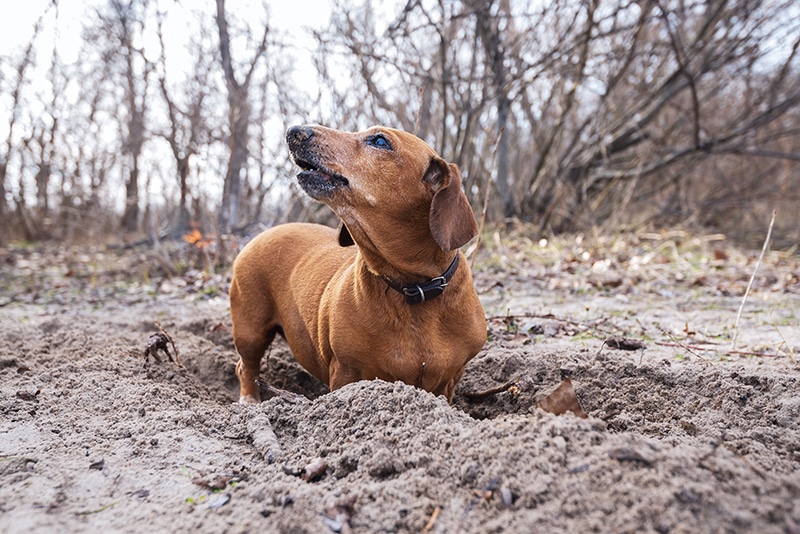
4. Digging:
Why do Dachshunds dig? Usually, it’s because they are bored. Dachshunds not only need daily walks to keep them physically fit, they also need some mental stimulation to work their brain too.
Here are some dog toy boredom busters that work really well!
Another reason for digging may be that their hormones are raging. Of course, the solution to this would be visiting your vet to discuss getting them spayed or neutered.
Your doxie may also be too hot on a summer day and wants to dig and lay in the cool dirt. Some Dachshunds just enjoy burying their favorite toy, digging in their food bowl, and covering their food with a blanket or toy. It’s a Dachshund thing.
5. Chewing
As young puppies, Dachshunds, use their mouths to explore their surroundings. They need plenty of chew toys and bones that they are Allowed to chew, so they don’t target something important to you and your family. Excessive chewing can also be caused by Separation Anxiety issues.
6. Aggressiveness:
Aggressiveness is the most unacceptable behavior in any dog. If your Dachshund shows their dominance towards other people or dogs, this may be from a lack of Socialization Training.
In other situations, it may be caused by their sex hormones, like high testosterone levels. Neutering is a strong recommendation for Dachshunds that assert their dominance because of strong hormones.
Reasons Your Dog May Be Showing Aggressive Behavior:
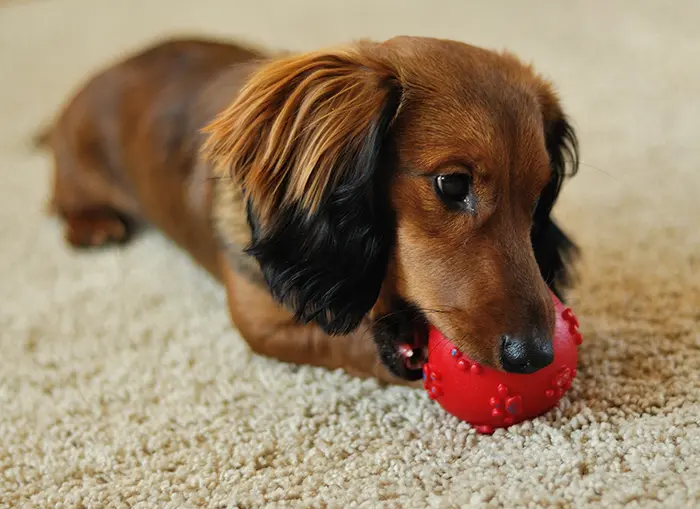
Dachshund Puppy Teething
Teething is a tough stage for our little Dachshund pups because their mouths can be very sore and they NEED to chew, chew, and chew to relieve the pain.
At What Age Do Dachshunds Lose Their Baby Teeth?
Dachshund Puppies can start losing their baby teeth around 12-14 weeks of age. These little pin-like sharp teeth are finally on their way out, Hooray! But, now what? Well, during this stage, puppies need our help to relieve their sensitive gums and teeth.
How Can I Tell If My Puppy Is Teething?
Do Puppy’s Teeth Hurt When They Are Teething?
Yes, losing 28 little puppy teeth can cause a sore mouth. To help reduce teething pain, puppies need lots of things to chew. During this phase, some puppies may eat less food than they usually do because of the discomfort of losing their teeth.
Be on the lookout for dangerous items in the house that the puppy may try to chew: electrical cords, toys, and furniture. Anything they can get their little mouth on, they will chew.
During the puppy teething stage, take a look inside your pup’s mouth every couple of days. Gently rub your fingers along the gums for a few seconds to get them used to being touched in the mouth. This will help them get ready for brushing their teeth and mouth exams by their vet.
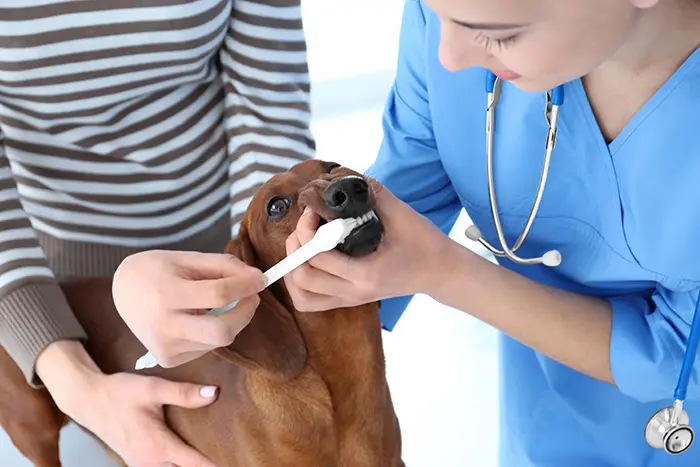
Do Puppies Get Aggressive When Teething?
Yes, puppies can become aggressive during the puppy teething phase. The puppy is working through this uncomfortable phase the best he can. Have some patience and give your puppy some space during this time. It hurts to get new teeth!
Do Puppies Swallow Their Baby Teeth?
Yes, sometimes your little pup will be chewing their favorite toy or food and accidentally swallow a baby tooth. You may find little puppy teeth on the floor or in their food bowl as well.
How Long Does Teething Last in Puppies?
The Puppy Teething Stage is usually complete around 5-6 months of age. But, wait, the next stage of chewing is called the development phase and that usually begins around 7-8 months old. This phase can last up to 2 years.
Should I Soften My Puppy’s Food?
If your puppy is having a hard time crunching through their dry puppy food, you can moisten your dog’s food with a little water for 5-10 minutes to see if that helps. Another option would be to mix their regular dry puppy food with some moist canned food. But, make sure to start this dog food change gradually to avoid an upset tummy.

Helpful Tips for Easing Puppy Teething Pain:
What helps a teething puppy? Here are a few tips to help make the puppy teething phase a little easier for you and your Dachshund puppy.
- LOTS of Chew Toys
- Frozen Snacks
- Prevent Unwanted Chewing
Chew Toys:
Look for safe chew toys that are BPA free and are appropriate for your dog’s age and size. Some puppy chew bones come in sets of multiple bones for different stages of teething. Also look online for reviews before purchasing a dog chew toy to make sure it is safe for your doxie.
Frozen Snacks:
Cold Carrots: Try giving your puppy a large chilled carrot (not baby carrots) to chew on. Carrots are full of vitamins and can also soothe your sore puppy’s mouth during the teething phase. Always supervise your puppy while he is chewing on the carrot and don’t let them eat too much, this may give your pup a tummy issue.
Frozen Treats: Freeze some low-sodium chicken broth in a dog treat freezer tray. Here are some more DIY frozen puppy treats from rover.com.
Frozen Washcloth: My puppy’s vet recommends tying an old washcloth into a couple of knots, wetting it, and putting it in the freezer overnight. This creates an easy to chew cool treat for your pup’s sore gums. Always supervise your pup while chewing on it, don’t let them eat it.
Prevent Unwanted Chewing:
When your puppy starts to chew the furniture or any personal household belongings, it helps to have them on a House Lead or leash that you used during Potty Training to redirect them to a toy that they are allowed to chew.
My Dachshund puppy, Eko, would chew on my couch corners and sliding glass door frame, so I had to block off those items with puppy gates, or science fair project boards where the gates wouldn’t fit.
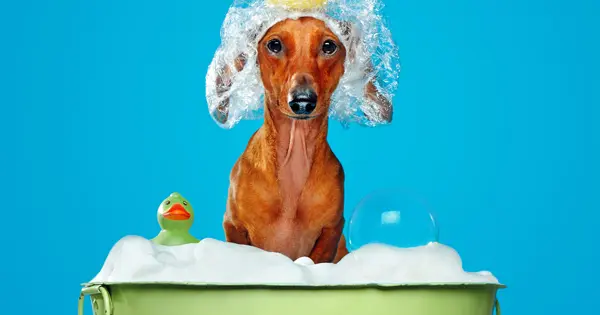
How To Give Your Dachshund A Bath
Here’s what you will need to make bathtime a whole lot easier.
- Bath Towel
- Beach Towel
- Soft Washcloth
- Rinse Cup
- Dog Shampoo
- Dog Conditioner (Long Haired Doxies)
- Dog Bath Brush
- Soft Dog Treats
How Often Should You Give a Dachshund a Bath?
Avoid bathing your Dachshund too frequently. Your Dachshund doesn’t need a bath more than once a month or even once every couple of months. The exception is if they roll in something super stinky that needs to be washed off pronto.
Washing your Dachshund too often can lead to itchy skin issues. Shampoo and water dries out your doxie’s natural coat oils and can change the pH level of their skin.
Bathtime Prep:
Before you put your Dachshund in the bath, do the following steps first.
- Set out all of your dog bath supplies ahead of time
- Gate off the room where you are washing your long dog
- Lay out a large beach towel on the ground
Bathing Your Dachshund: Step-By-Step
Dachshunds need to have a positive and safe experience during bathtime in order for things to go smoothly.
Note for the Long-Haired Doxies: Gently brush through their hair before the bath to remove any tangles.
Fill The Tub: Fill the bathtub or sink with a couple inches of lukewarm water. Just enough to cover your doxie’s paws is deep enough.
Face First: Start washing your Dachshund’s face first. Add some bath water and a tiny bit of dog shampoo to a soft washcloth and gently clean around your Dachshund’s head, nose, ears, and neck.
Avoid Your Dachshund’s Eyes!
Rinse off the washcloth with clean water and wipe your doxie’s face again. Never pore water on their head, just wipe the soap off with a rinsed cloth. Give your pup a small treat and praise them with “Good.”
Note: Don’t use human shampoo. Dog Shampoo is specially formulated for your dog’s fur and skin.

Rinse: Rinse your Dachshund’s body by pouring some bath water down their back and under their belly using a rinse cup and your hands.
Body Wash: Add some dog shampoo to your dog bath brush and gently wash around your doxie’s neck and back. Dog bath brushes do an excellent job of cleaning off dead skin cells and dirt. If you don’t have a bath brush, you can just use your fingers to lather up your pup.
Be extra sensitive around your Dachshund’s belly and armpits. I like to use a soft washcloth for those areas. Make sure to wash them everywhere: belly, chest, legs, paws, under the neck, tail, and under the tail too (save that for last).
Rinse: Pull the plug and empty out the dirty dog water. Rinse off all the shampoo from your doxie with clean water from the faucet (lukewarm temperature).
Rinse Again: Use the rinse cup and your hands with this step to squeegee the shampoo off of your pup’s fur.
Reward: Give your pup a small treat and praise them with “Good.”
Long Haired Dachshunds: Apply Dog Conditioner to your doxie’s luscious mane. Then, rinse them off thoroughly.

Dry Off – Face: With a soft towel, dry off your Dachshund’s face, ears, and neck first. Use a couple of soft tissues or cotton balls to gently dry out the inside of their ears if they are wet.
Dry Off – Body: Here comes the fun part! Most Dachshunds will get the crazy zoomies when they are released from their bath. It’s hilarious to watch. As your Dachshund skootches on the grounded beach towel, use your other towel to help dry off their back and sides.
Dachshund Parent Support Groups
Got Questions About Your Dachshund? Join our Team Dachshund Facebook Group, where you can connect with fellow doxie parents to share experiences, ask questions, and of course show off adorable photos of your pup.
If you are a doxie mama, check out the Dachshund Mom Club, it’s a fantastic community of new and experienced Dachshund mamas sharing advice, answering questions, and bonding over their love for these little long dogs.
Don’t forget to Follow Dachshund Station on YouTube, where we’ve turned many of our Dachshund Guides into easy-to-follow videos. It’s a great way to learn and laugh along with us on your dachshund journey.

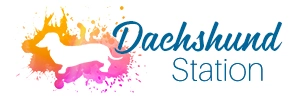



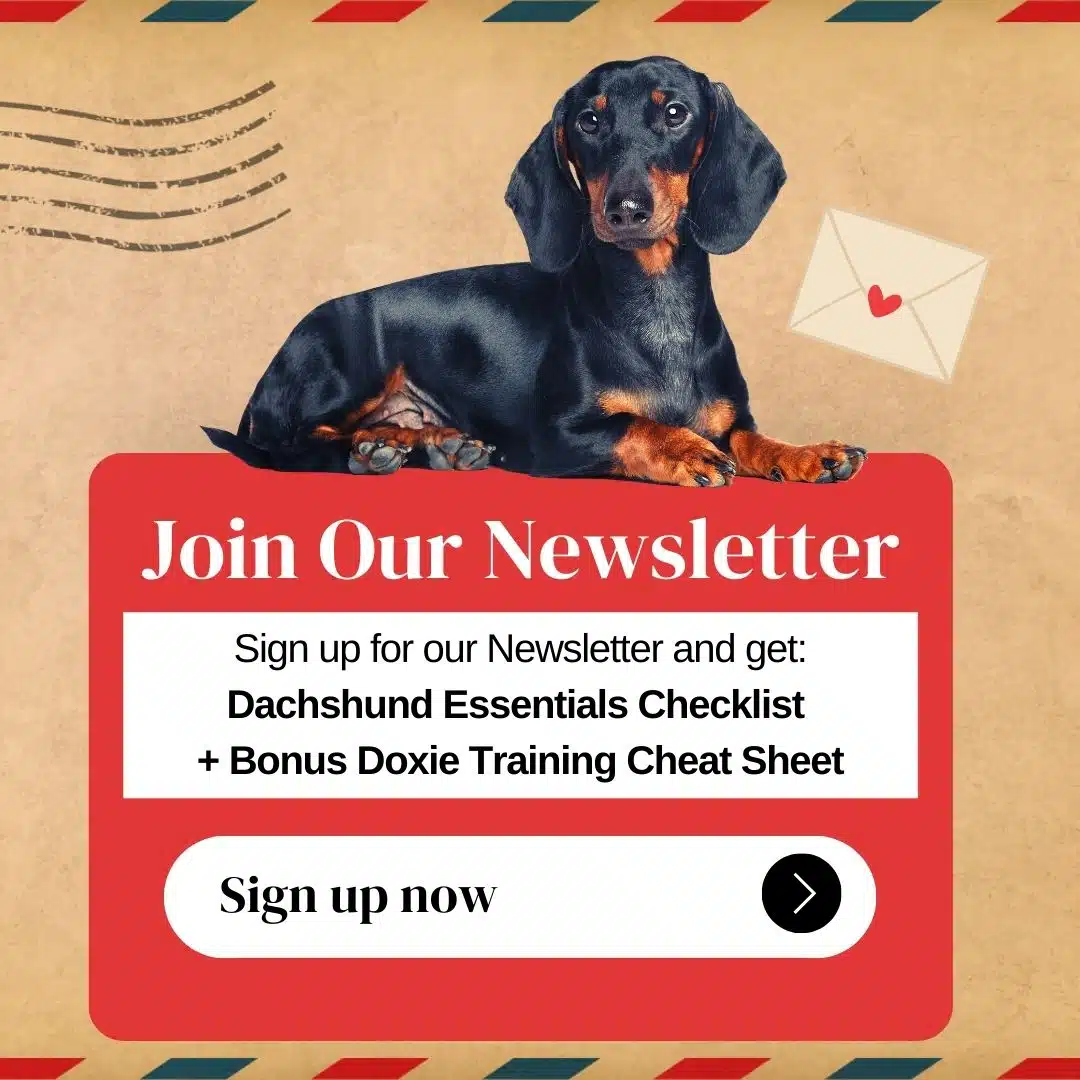
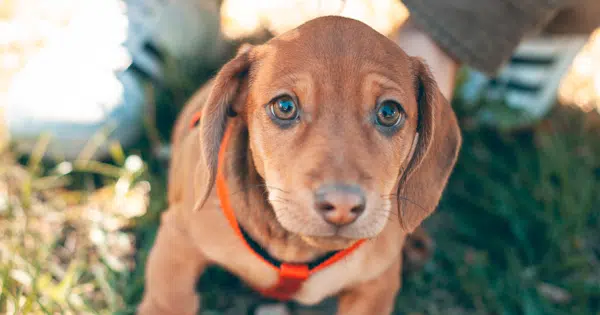
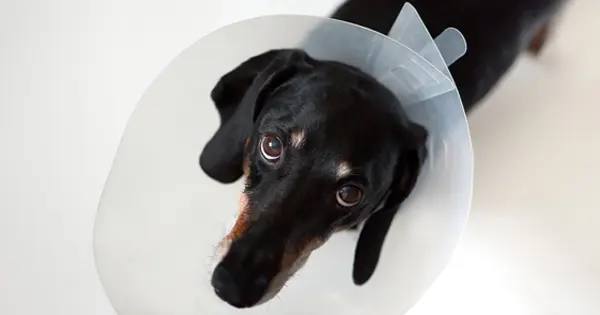
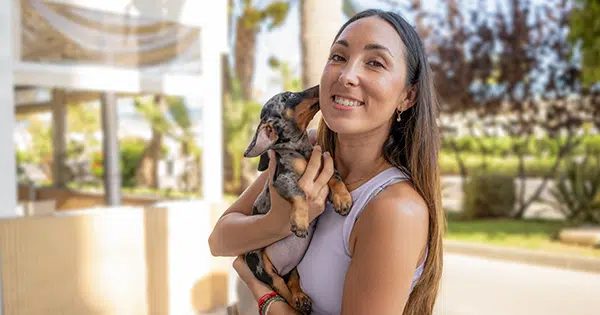
There is so much great information on here. CAN I PLEASE have someone to tell me how to print this wonderful information. I hope to be getting my 8week dachshund female to after spade
Hi Kimberly, YAY! New dachshund puppies are so exciting. What a nice idea, thank you. A super helpful Dachshund Essentials Checklist + Dachshund Training Cheat Sheet is now available through our newsletter sign up.